just for a few hours: out of the insanity of the insane and dementia patients and psychopaths ruling the world, inside and outside of government
Sure, I live along the Central Coast of Oregon. How many times, even in my small memoir writing class I am conducting, to people tell me they are “living on/in the planet’s most beautiful place.”
Just yesterday, two older ladies I met on the beach near my humble abode who were getting too close to a California sea lion. Taking pictures. So, when the animal allows Homo Consumopethicus to get close, there is something wrong.
Big animal, maybe two years old, a male, skinny, and along our Alsea River, where we mostly have 600 harbor seals hanging out on sand spits, their haul out of choice.

Yep, I yelled from a distance, but then I had a conversation with them about wild animals, the sea lions versus seals, and why this fellow needs some space — sick, skinny, fatigued, and probably on his way to mackerel heaven.
One lady’s from Boston, and the other one from Portland, now living here.
I told them about the “Land-Sea Symposium” in the Yachats coming up at 5 pm, part of the Cape Perpetua Collaborative, which sponsors the event.
Cape Perpetua Marine Reserve is one of give where I live, and the blurb on-line I repeated with a bit more force to these two ladies who I was able to get to move away from the sea lion, telling them about 500 feet rule, and how to zoom in with the dumb phone.

“It’s really great to see this kind of community response to the symposium. It shows that people care a great deal about this very special place between the land the sea.”
I went, and I did not see them there (no surprise). But it was my way of decompressing from the constant worry and shame and disgust and revolt and revulsion I have been feeling since Oct. 7, well, make that Oct. 7 1975? Shit, Iran-Contra, all the way through to now, the Hamas attempt at getting hostages free, Thousand of them locked up and tortured by the Jewish State (sic) of Israel’s thugs, well, that’s all of the Jewish Community of Israel, mas o menos.
Here, a perfect opportunity to talk with and listen to scientists and researchers focusing on tide pool creatures, sea stars, grey whales, pollinators and sea birds.
Sponsors offered beer, wine, cider and samples of various ocean-reliant foods. And pizza.
“It’s just a great way to showcase so many of the things going on here,” so says the director.
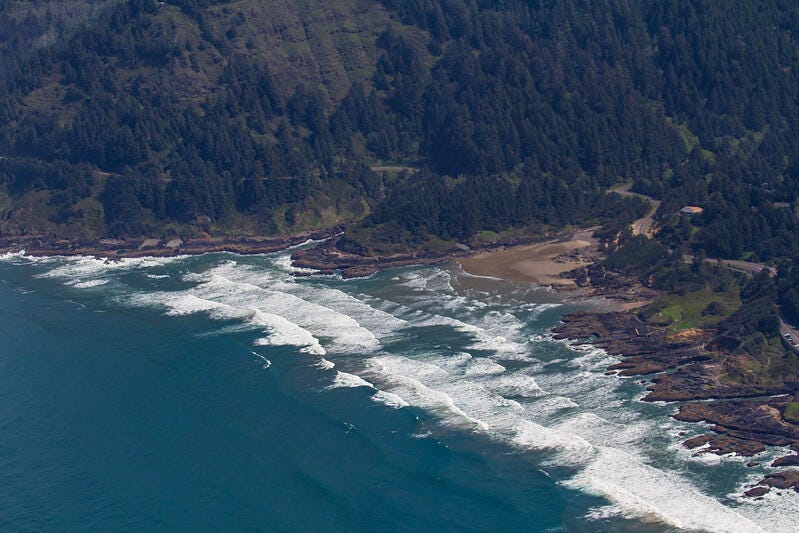
I’ve been here since 2019, and I’ve written about amazing people working on ocean and land and wetlands issues. I’ve become again a naturalists for the American Cetacean Society. I’ve worked with poor people and homeless folk, with developmental delayed clients, and I have had columns in two newspapers, one of which became a book out there on Amazon — Coastal People inside a Deep Dive: stories about people living on the Central Coast and other places in Oregon.
Here’s what we talked about yesterday:

An aerial veiw:

Before the speakers spoke, and before a benediction, and before the one fellow who catered the event read his poem at the end, I talked with many of the folks staffing the tables:

There were others — friends of Otter Rock, Mid-Coast Watershed Council, Sea & Shore Solutions, Concerned Citizens for Clean Air, Highway 101 Pollinator activists, others.
I talked with a young woman staffing the Forest Service table. She had a diorama (small) of a plover and its eggs. We talked, and she is all about outdoor education and public outreach. She is from Minnesota, got her biology degree from U of Wisconsin and she’s doing an internship here on our coast, again, taking science to the kids outside, where the world meets the mind.
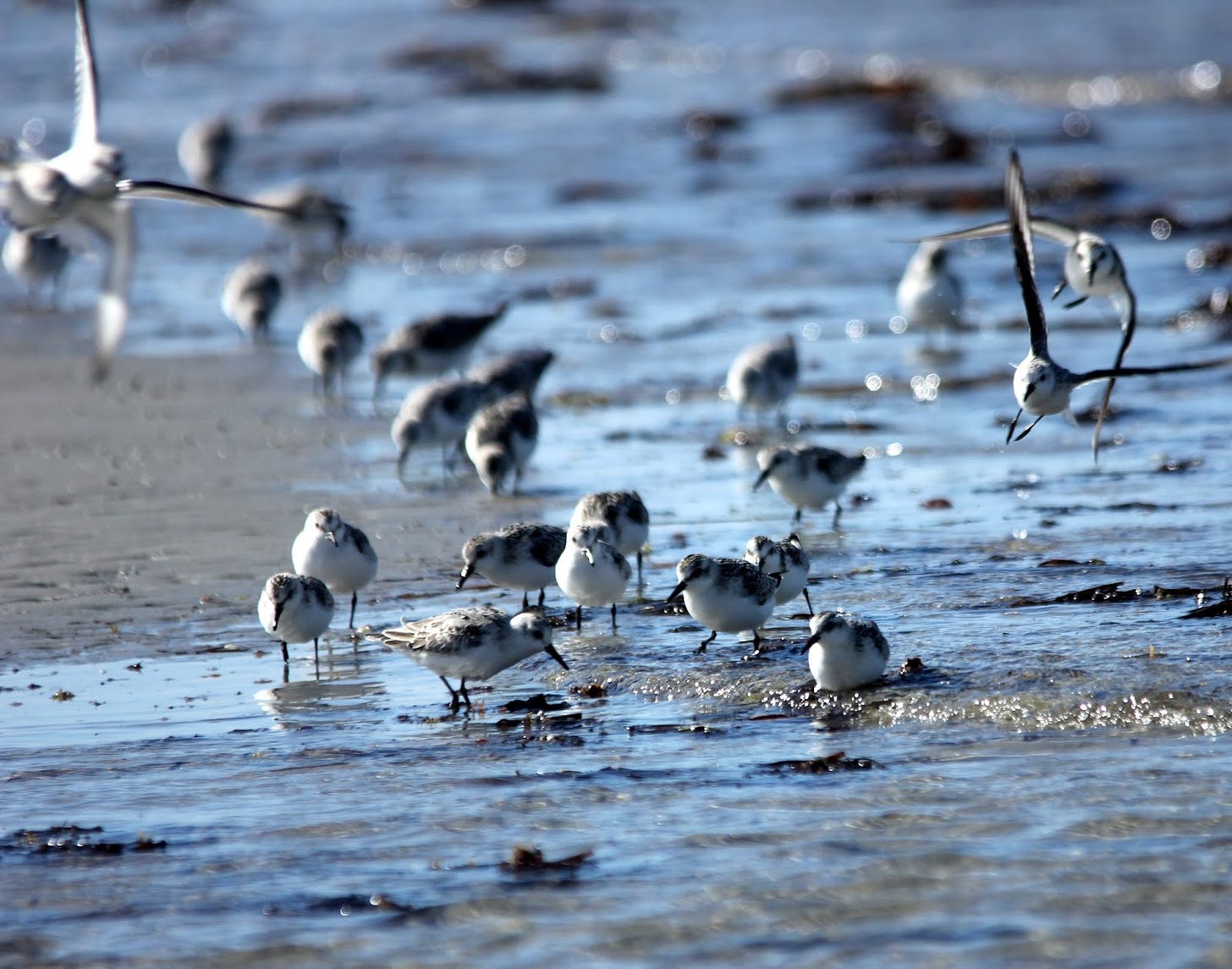
Total enthusiastic person, and she’s ready to leave in December and end up in McCall, Idaho, with the University of Idaho’s outdoor education school there. MOSS.

McCall Outdoor Science School (MOSS) K12 programs aim to foster the skills and competencies necessary for people to live well in their social and ecological communities. Graduate Student Field Instructors facilitate learning experiences for youth in MOSS programs and practice using inclusive instructional strategies in their teaching practicum. Through hands-on exploration of the environment and guided inquiry, participants observe and investigate the relationships between biological, physical and social systems around them. Our goal is to help participants develop a sense of place, build scientific literacy, and develop effective communication and collaboration skills. Collaborative learning between graduate students and K12 MOSS participants allows for expansive understanding of social and ecological relationships.
I’ve been harping on this for decades — not just one MOSS school in the middle of nowhere, but in EVERY community, in all urban or suburban or rural locals. Funded by the takers, the millionaires and billionaires. It’s the only way to get young people active, turn them into activist thnkers, put revolutionary zeal into their DNA, prepping to be ready to battle the impending slipping ecosystems and weather chaos. To get them away from all the brainwashing, brain-hacking, brain-numbing, brain-slicing techno crap of the AI-VR-AR-MR variety.
I talked to a fellow from Stuttgart, who has been here, USA, with his wife working with the Forest Service, specifically with the Marine Reserves program. He speaks four languages, went to school in Quebec, has a PhD, and he’s loving working in Oregon, a world so different from oppressive Germany that I have seen that twinkle in the eyes many times in Germans transplanted here, and in places like the Sonora or Chihuahua or even Guatemala.
Joan Kittel opened the conference. She’s the person who brought to light the Amanda Trail. Read here: A poem I wrote:
Not Just One of those Tales of Another Dead Indian
bloody feet dampen soil
her DNA cleaved to earth, forced blind trek
called “a march” yet she sees through
darkness, earth torn for steel
guns, rusty crosses, parchment
proof of broken treaties
tears bleeding into wind
signatures of unholy
men worth the indigo
nothing more, promises, lies
before US Military kidnapping, white mountain
man grabbed her
fornicated, child from uncommon
law, but mother thrives
until march of tears
from beachhead south
into basalt canyons
toes bound by scars
stumbling, old blind woman
disappeared, or bones to dust
reality: Amanda De-Cuys was a blind Native American woman of the Coos tribe
who traversed coastal trail 158 years ago, but not by choice.
she fled to Coos Bay, but designated runaway
she was tagged like elk, as US army men
carried-out forced march
seventy-five miles north
daughter left behind with common
law gringo, 12 of them
prodded by uniformed glory
now a land of colonization
a continent crying slow death
in 2022 mostly gray heads
gather at the grotto
rededication of new
bridge, Amanda’s Trail
statue of blind Indian
these people hold court
listen to speakers
the mulch of Oregon
forest like fungi on tongues
Yachats, hippie town
tears of Umpqua, Coos, Siletz, Alsi
forever there, a mist
a new rainbow each time
a new visitor hikes hoping
Amanda’s song is caught
in kingfisher or murre or guillemot
transmigration of natives’
souls
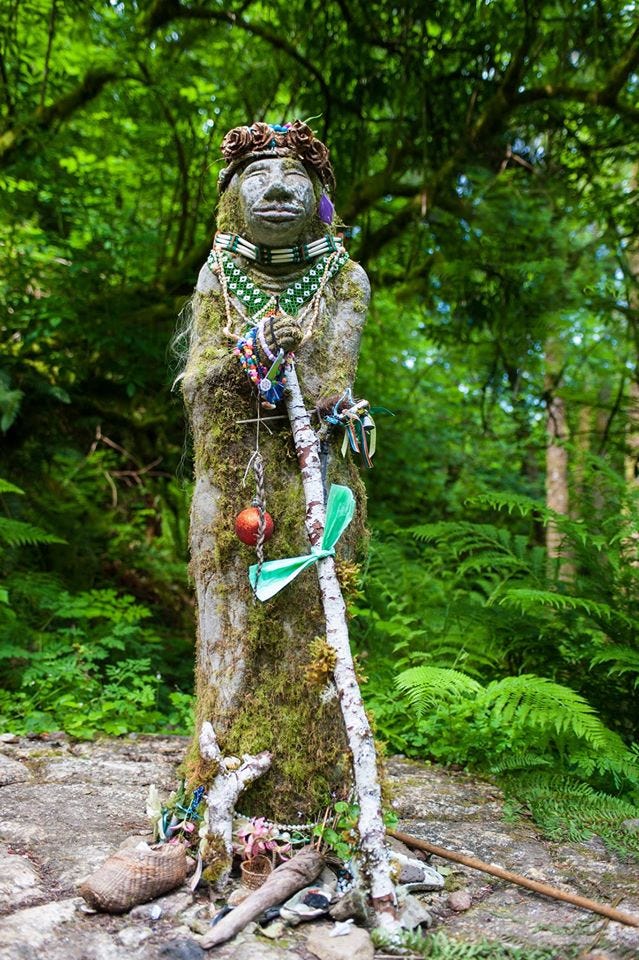
Kittel: “Amanda Trail, and the more recently the Ya’Xaik Trail, were built on a foundation of the truth, building trust between cultures. As such, no person-made or natural disaster will ever obliterate them. They will endure bringing joy and grace to all who walk their paths. (some more history)”
Joanne takes the pain of the Indians seriously: Professionally, Joanne is a psychotherapist who specialized in treating victims of trauma and perpetrators of trauma. Her work includes those affected by historical trauma. Joanne is a long-term member of View the Future (VtF), beginning with the organization’s earliest days. She has written and presented on the history of the First Nation People who lived in the Yachats Area for thousands of years and their forced March and internment during the 1850s. In addition to VtF, Joanne also participates as a: member and Trails Development Leader of Yachats Trails Committee, Volunteer and Trainer at My Sister’s Place, Member and Vice-chair of Angell Job Corps’ Community Relations Committee, Member of Secure Resources Advisory Committee of Siuslaw National Forest and is a past member of multiple local nonprofit Boards and groups.
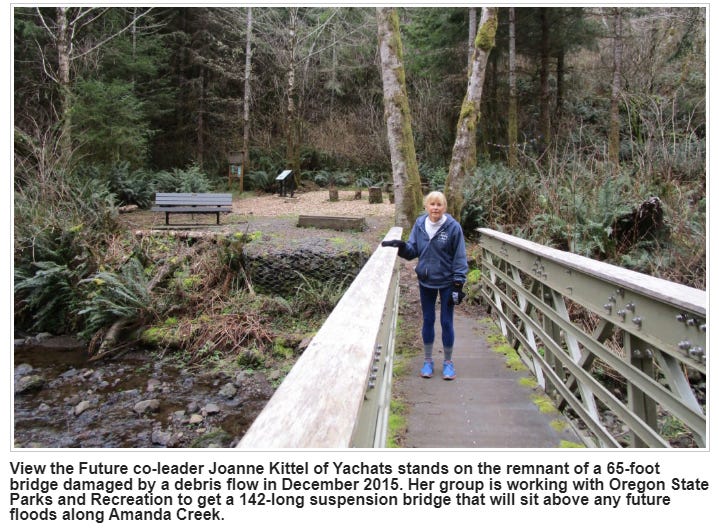
The reality is I was the only one of a hundred there with a tribue to Palestine — my keffiyeh proudly wrapped around my neck!

Oh, the Coos and Siletz and Umpqua tribes had their trail of blood/tears/death, marched north, barefoot, 80 miles to the “reservation,” the military station, a prison, here in Yachats in 1860. Genocideal policies of starvation, disease and depression of spirit did the community in. In 1865, oh, those Pioneers, robbed the Coos of 900,000 acres the government “deeded” to them.
Note: The Board of the Cape Perpetua Collaborative and the staff is mostly women — Amber, jamie, Liz, Cheryl, Megan, Ava and et al. This evening was mostly old people in the audience but young people presenting and staffing the tables.
The collaborative was created in 2017, made up of conservation groups, agencies, NGOs to specifically research and conserve the Cape Perpetua area.
Yeah, the Yachats Mayor spoke, and our representative in Salem, 10th district Rep Gomberg, he pontificated. His district includes two marine reserves, including Cape Perpetua. He mentioned how a billion dollar investment in new housing was approved by the state legislature, and as is the common shit of USA capitalism and uniparty politics, there was no funding legislated for sewer and water delivery. Insane. Replicated from state to state.
We are an aging country (infrastructure), blasted into decay by Predatory-Criminal-Usury-Military Captialism. He also talked about how small cities can’t afford millions for dam mitigation or removal and construction. And there are land acquisitions we pay for (taxpayers) to get land “back” from the timber and insurance industries.
One bill of interest is tied to his interestingly open lament: “What is the greatest threat to open land, open beaches, and access to public forests and places?”
Lawyers. One trip over a root, one fall from an overhand, a scratch or broken leg, and the dirty lawyers swoop in like rabid dogs. All the litigation drains state and federal agencies, and even cities and counties face the same fucking dirty capitalist shit – sue sue sue.
There is a bill he is hoping to see get voted on so our open spaces don’t get shut down because of lawsuits draining staffing and servicing: Recreational Immunity legislation.
Okay, the first presenter! Science!
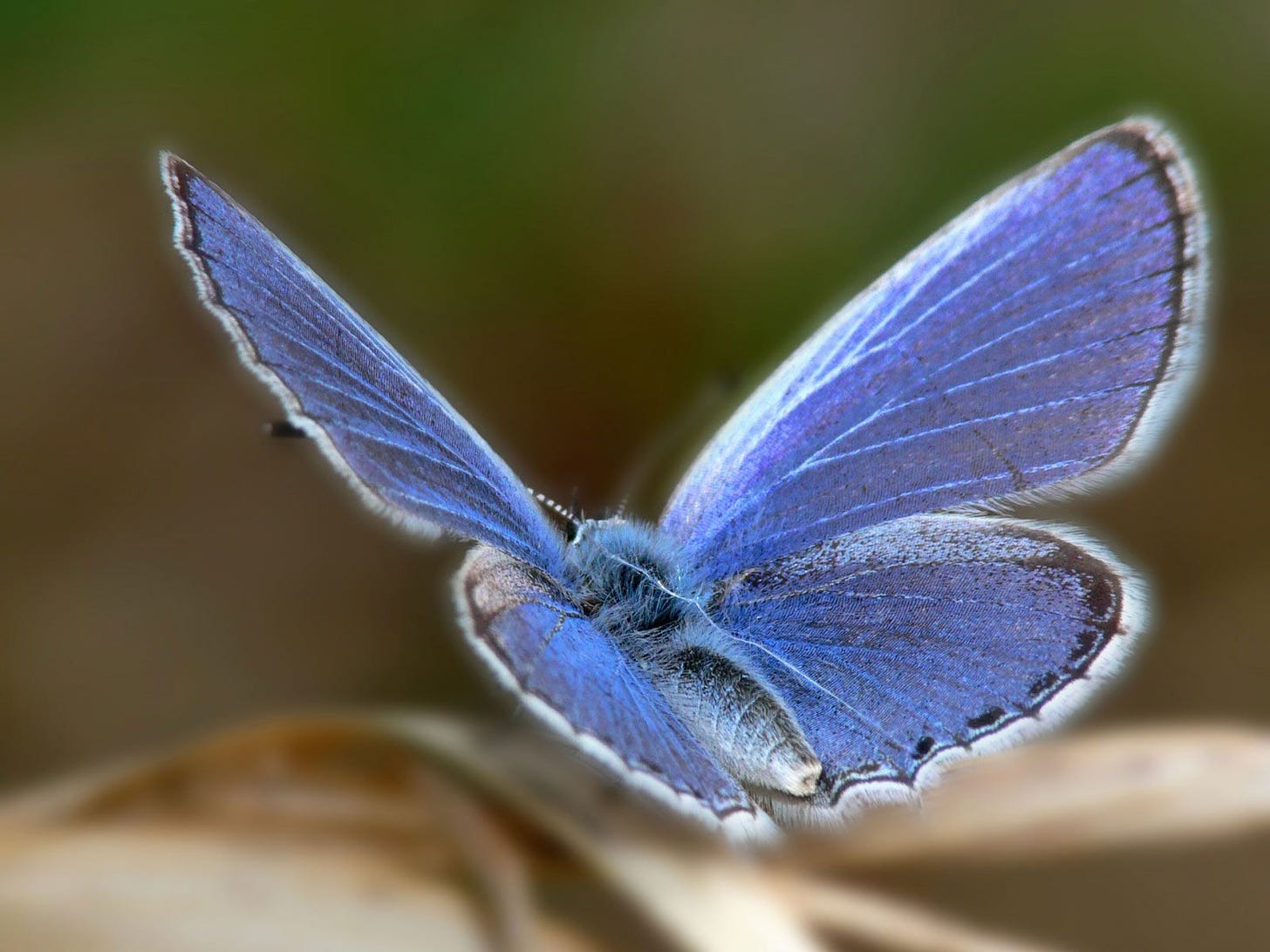
I talked with Dave Kollen with the Xerces society, named after the butterfly above, last seen north of San Francisco in 1943.

You betcha I am right there with this conservation movement having done a biological transect in Vietnam and other places to see/research on/write about the health and the sagging ecological connectivity of ecosystems, forests and jungles and reef systems.
He’s a tall guy, sort of a young Walt Whitman, with dry humor, with a country-fied accent, but his presentation hit home —
Pollinators are essential to our environment. The ecological service they provide is necessary for the reproduction of over 85% of the world’s flowering plants, including more than two-thirds of the world’s crop species. The United States alone grows more than 100 crops that either need or benefit from pollinators, and the economic value of these native pollinators is estimated at $3 billion per year in the U.S. Beyond agriculture, pollinators are keystone species in most terrestrial ecosystems. Fruits and seeds derived from insect pollination are a major part of the diet of approximately 25% of all birds, and of mammals ranging from red-backed voles to grizzly bears.
Unfortunately, in many places, the essential service of pollination is at risk from habitat loss, pesticide use, and introduced diseases.
Nerdy? You betcha:
Sure, we can see how pollinators really give us our food:


His role in the Society is working on native pollinators, and Oregon has it’s bees — over 800 species. Mostly they are solitary, nesting in the ground or inside dead limbs.
The ground nesting ones (70 percent of all bees in Oregon) face land clearing, persticides, climate change, invasive species, and so much more. Then around 30 percent of bees are renters, cavity nesters.
And, with this fact — 1,000,000,000 pounds of pesticides, fungicides, other-cides used each year — we are in some bad shape. Welcome human chronic illnesses and neurological diseases, by the boat load.
The decline of insects/invertebrates directly connects to a major decline in birds. We are talking about 3 billion birds declined worldwide last year. And most birds depend on eating invertebrates at some stage of their lives.
Coastal Greenish Blue — in the past hundred years, only 30 have been seen, recorded.
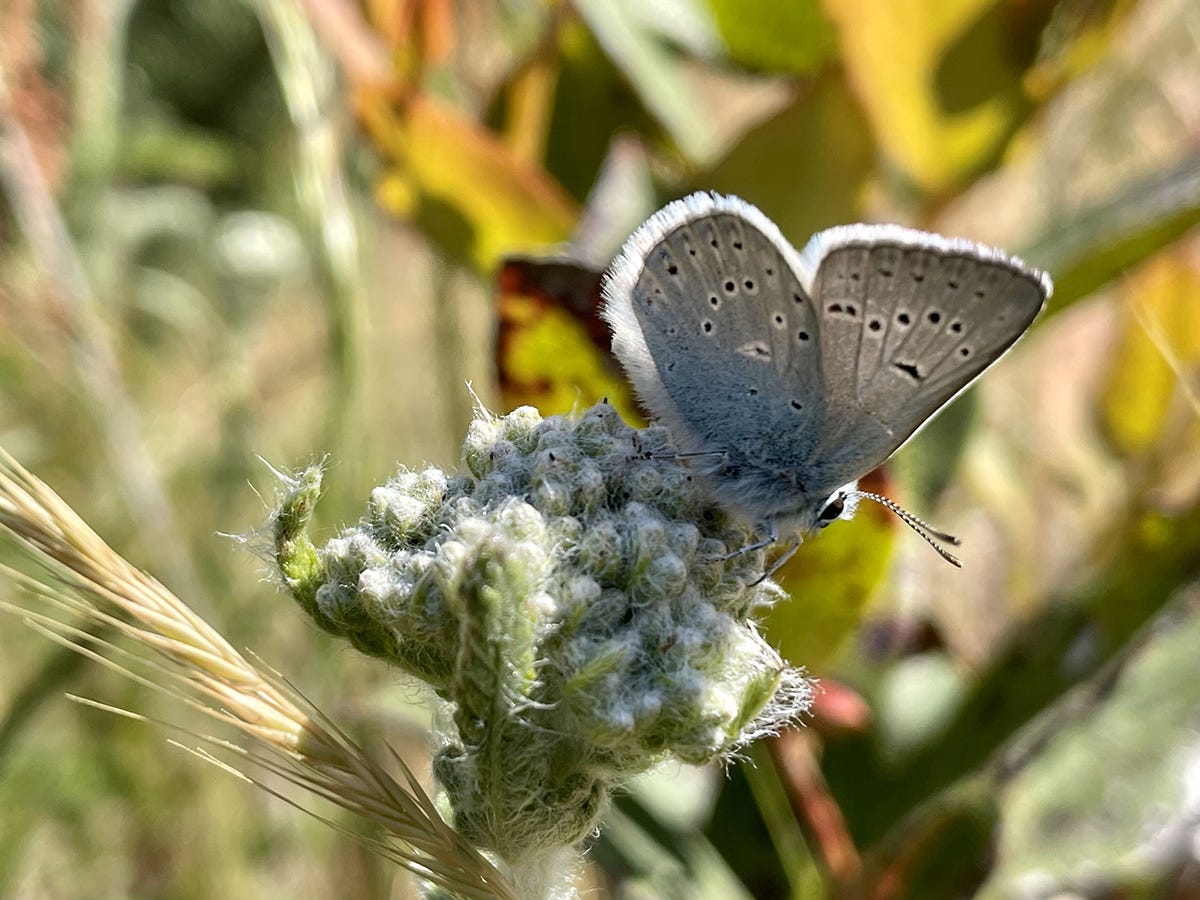
Siuslaw Hairy-Necked Tiger Beetle — almost all gone:

Our Western Bumblebee (20 species) has seen a rapid decline sine 1990. Parasites, pesticides, habitat loss, disease and off-road vehicles taking it out as a species in the West.
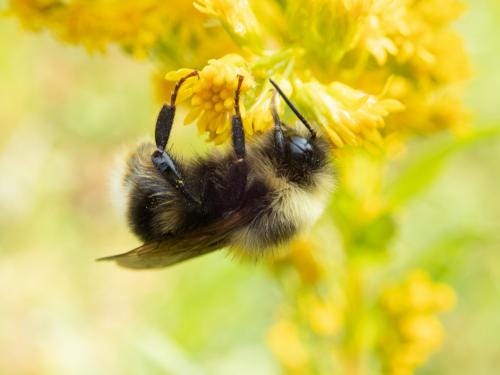
Western Pearlshell Freshwater Mussel? Unexplained die offs, reproduction rates dropped.
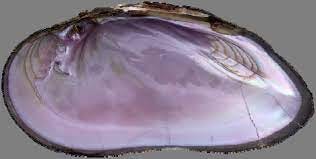
The final push is for no pesticides or so much less pesticide use, sure, that’s what we do in predatory and dog-eat-dog capitalism. Citizens use more pesticides on landscapes than do farmers. The toxicity of these chemicals have destroyed the entire web of life, including apex predators like Homo Consumopethicus.
There are programs I know about and have initiated in the past — Bee Cities and Bee Campuses. Go to Xerces for more info.

Next, Jamie Kish, a Tidepool Ambassador with a comedy streak that makes life fun, learning a hoot. In a word, she was a laugh a minute, and her presentation was hilarious and informative. She’s volunteered since 1999, and has worked at the New York Acquairum, Disney World, and for cruise ships in the Bahamas.
She’s a field guide and program associate. She’s been doing this for three years, and her enthusiasm for these critters and for her work with young and old giving tours of tidepool ecosystems is her dream come true.
“Being up at dawn with the first human footprint on the beach being min, this just does it for me.”
Each species in the tidepool is a character in her own tidepool tales. She is also a photographer. The audience was laughing up a storm as she recalled her work with the species and that includes human species.
This is the respite I was just after. Her biggest thrill is when people about to start her tours ask, “How are the stars doing?”
For the ochre sea stars, that were decimated with wasting disease (a virus), they are coming back big, with thick contellations and big specimens.
Infectious laugh? Jokester? Teacher having fun while students learn a shit load? Yep.

More information on the tidepool ambassador: Check out Jamie’s photography.
Quoting some more background: Between Florence and Yachats lies the Cape Perpetua area, a biodiverse recreation mecca home to lush coastal rainforests and deep cultural history. But past the coastline also lies the largest Oregon marine reserve. The Cape Perpetua Marine Reserve site is a 33-square mile area dedicated to conservation and scientific research. Just like parks and protected natural areas on land, there are multiple benefits of protected areas in the ocean. They conserve ocean wildlife and biodiversity. Marine Reserves sites also serve as living laboratories, where we can learn about marine reserve protections and Oregon’s ocean environment to help us maintain our seas for future generations.
Trained guides provided tidepool tours for small groups and volunteers roamed tidepools to engage with visitors about the local in habitants of the tidepools, Oregon’s marine conservation efforts and to promote marine stewardship. We hosted 2 tours/day over 25 negative tide dates. Guides and volunteers engaged with over 800 people throughout the season, with 140 people signing up for an intimate tour, which included a span of generations. Tour guests were very enthusiastic and appreciative of the program. It was really exciting to have a mix of generations and each tour brought something different in their experiences.
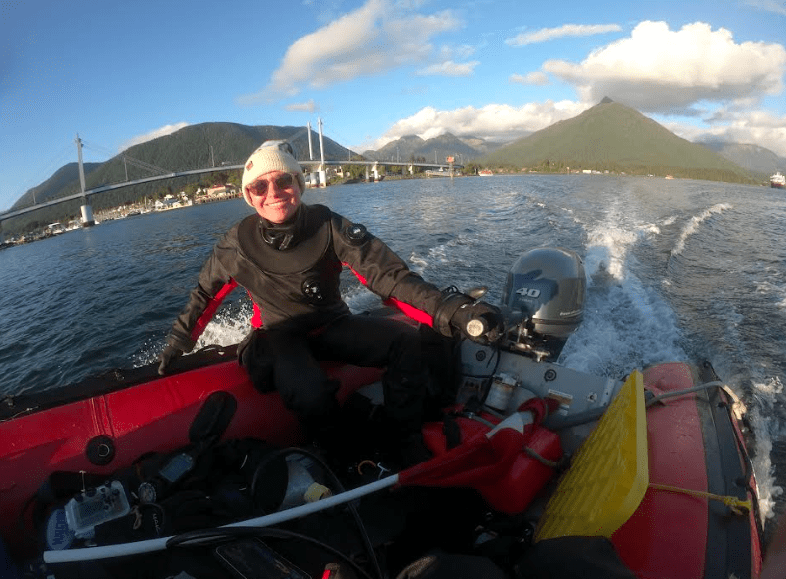
Next up? Oregon State University biologist and diver Dr. Sarah Gravem [photo, she motors past Sitka on her way to a kelp forest she is monitoring. Photo by Jake Metzger.]
She followed Kish on stage, and again, fun, laughs and turning science into a learning and entertaining form for the crowd, who was laughing it up as much as they did with Kish’s presentation.
Here, from Alaska’s Native News:
+–+
Oct. 6, 2023: A few weeks ago, Sarah Gravem lowered a “ravenous, terrifying predator” from her boat down to the ocean floor off Sitka. Then she released it.
In a slow-motion drama, sea urchins fled as a pizza-size sunflower sea star oozed toward them.
Gravem explained: “I release one right in the middle and watch everybody freak out. It’s not just that they eat them, but they scare them. (Urchins) leave and they don’t come back.”
A biologist and diver at Oregon State University, Gravem is trying to understand whether imperiled sunflower sea stars are beneficial to kelp forests, which have also greatly diminished in the last decade.
Sunflower sea stars — recently decimated from the ocean off western Mexico, California, Oregon and Washington — are like wolves of the kelp forest, eating sea urchins that will overgraze if left unchecked, often with a scorched-earth result.
In Sitka, Gravem’s students and research team members have spent much of the summer working out of the Sitka Sound Science Center. Each morning, they boat out to kelp forests to study the relationship between sea urchins that eat kelp and sunflower sea stars that eat the urchins.
Sunflower sea stars can be as large as a trash-can lid. They grow up to 25 slimy arms. They are one of the largest sea stars and are the fastest, using thousands of coordinated tube feet to move a meter every few minutes. They live 30 years. And they are feared eating machines.
“Anything they can catch, they will eat,” Gravem said over the phone from Sitka as her diving gear dried. “They will shove an urchin inside their stomach and later spit out the empty shell.”
There are not many sunflower sea stars remaining in the Pacific Ocean. Sea star sunflowers are victims of a wasting disease, perhaps a virus, that killed 5.75 billion of them in a recent five-year period. It is difficult to find one today off the coast of California, Oregon or Washington.
“There used to be thousands of them marching around all the time,” Gravem said.
The sudden absence of the sea stars has been bad news for kelp forests off the Lower 48 and has been noticeable all the way up to Alaska, where there has been a 60-80% decline in the last decade.
Gravem, who has studied the sea stars the last five years, recently visited a former kelp forest about a mile offshore of Sitka, where today “there’s not even a scrap.”
Kelp forests are important because they provide fish with places to hide and provide sustenance for many other creatures.
“They’re like trees,” Gravem said, “but they’re even better than trees. Most every herbivore eats kelp.”
Kelp forests disappeared en masse following the staggering loss of sunflower sea stars.
“With no sea stars, sea urchins had gangbuster years,” Gravem said. “Some places, they increased tenfold.”

I’ve written about sea stars and urchins and kelp before. About yet more women PhD’s (or some without doctorates) working on ocean issues, including the benthic zone: One Woman’s Research on Aquatic Bioinvasions, Seaweed, Wave Energy
You want an hour-plus of Sarah explaining the intricacies of that web of life? LINK.
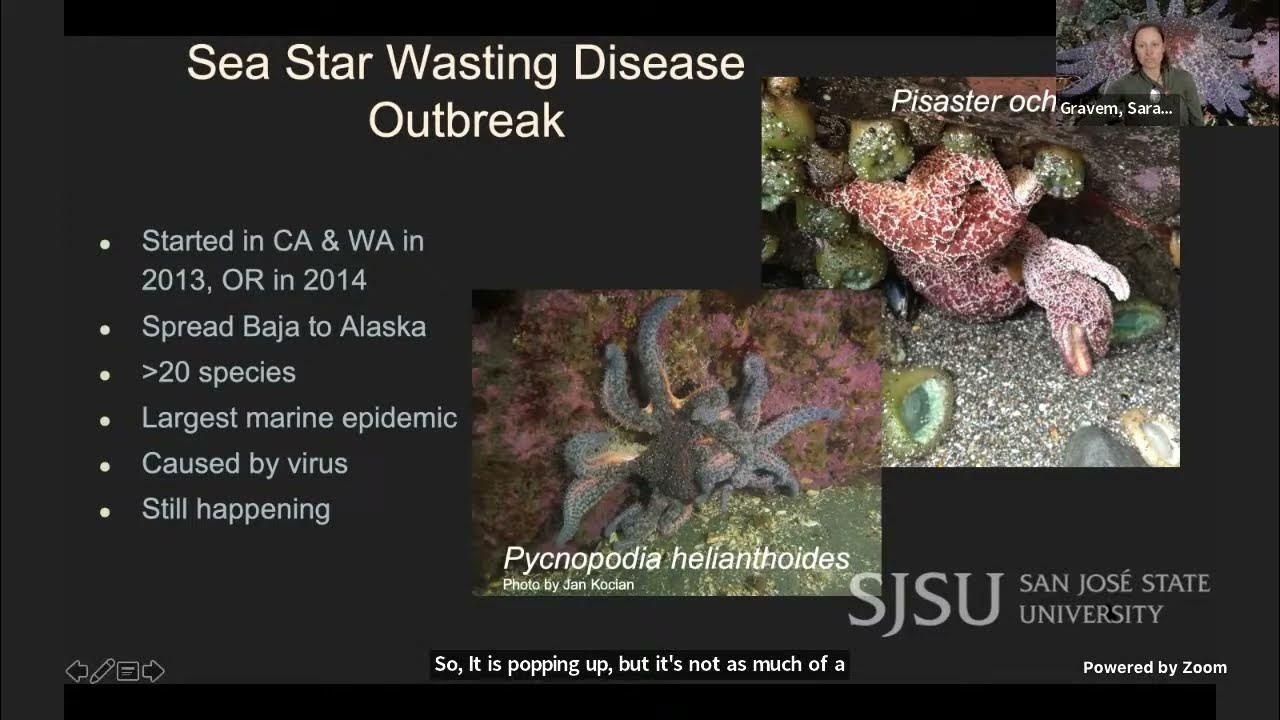
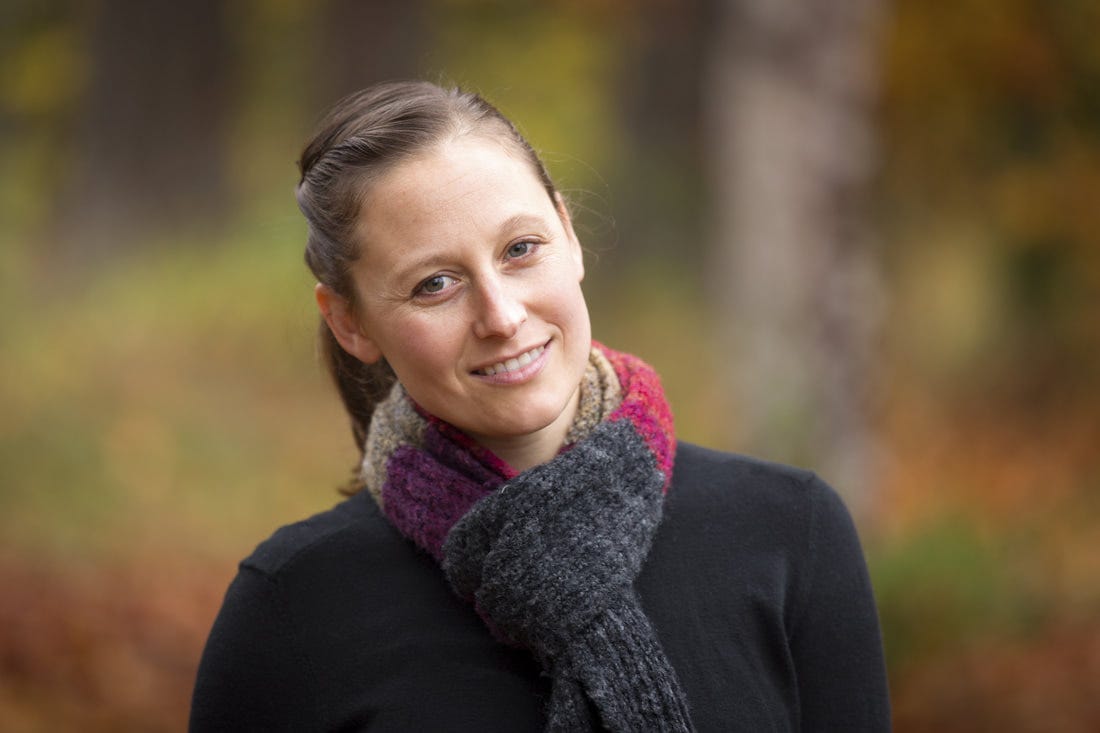
Next: Drones, geospatial research, PhD candidate, gray whales, OSU, and so we hear from Clara Bird, after Sarah. She was also attempting to be humorous, and I have heard her speak. several times, and I know her work. But for the crowd, the drone footage of those mammals are always awe inspiring.
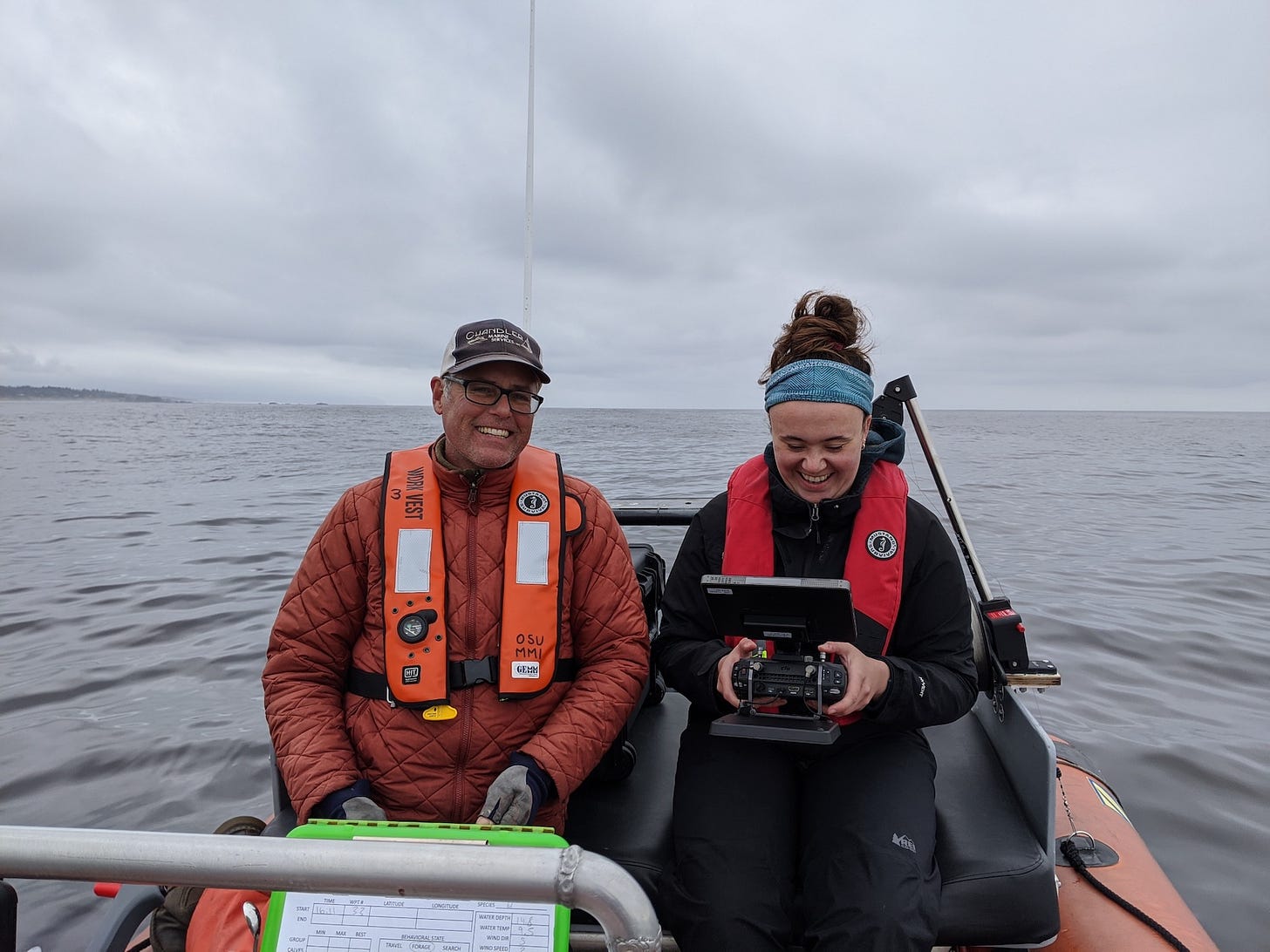
The fact is that some drone work is positive, and scientists can get three times the observational capacity from drone footage. Clara’s work is around our special group of gray whales, the Pacific Coast Feeding Group, a unique sub-ground of east Pacific whales. Therea re around212 of them, and they are definitely well studied, photographed, and so many return to our shores, Depoe Bay, especially, so their feces and size and body mass and other aspects of their well being can be studied and compared season to season, year to year.
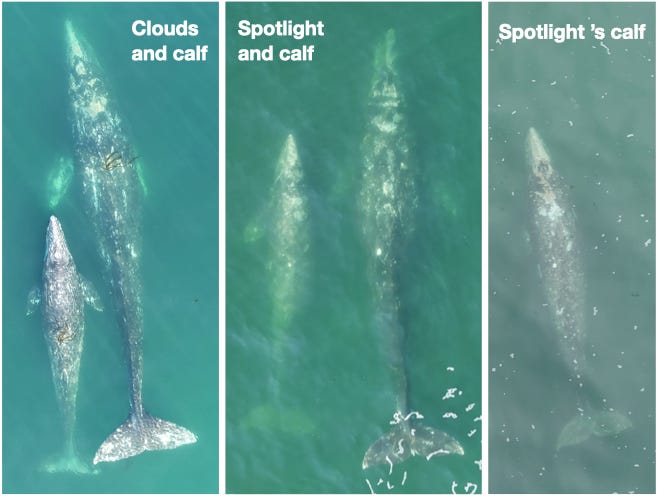
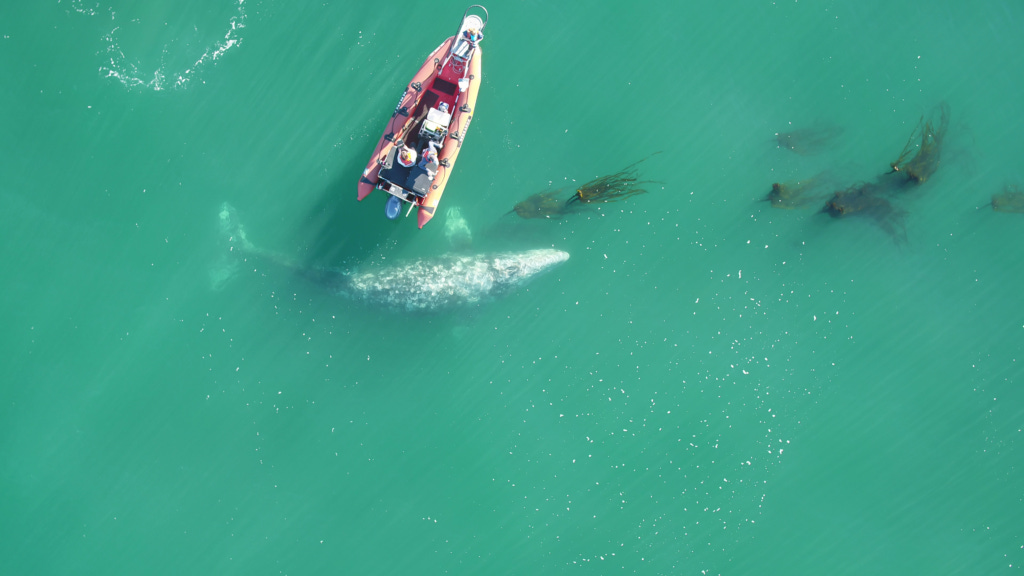
The whales keep coming and we keep learning: a wrap up of the eighth GRANITE field season.
Here, an hour:
Her biggest work is around 8 different feediseng habits of our Pacific Coast Feeding Group (PCFG). It’s deep biology, looking at sexual dimorphism, resource polymorphism, ontogentic shifts, and individual specialization.
Depth and Body Weight Mass and length and the type of benthic zone they feed in are part of the research she does to complete her PhD next year.
This is kick-ass work, a break from my own work learning how to SURVIVE in this fucked up mess.
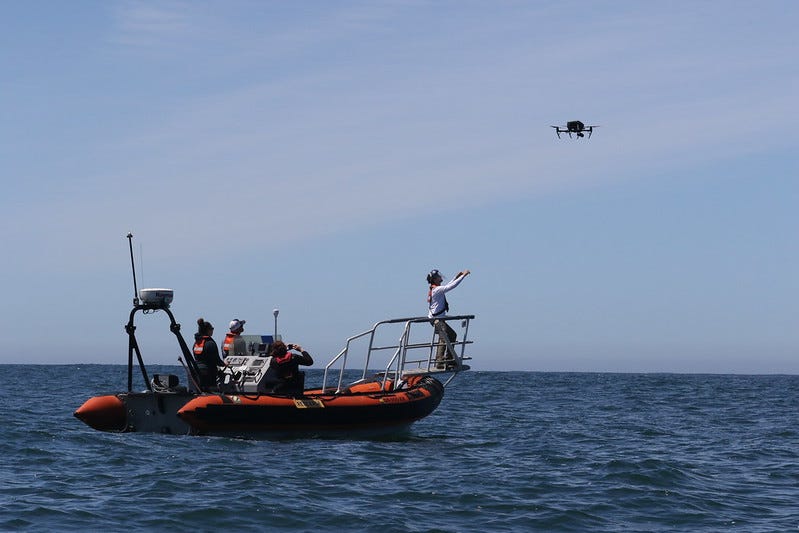
I’m a diver, a 66 years old who did the dive bumming at age 15 in the Sea of Cortez. I’ve written tons about that. I am in a different space, now, probably shackeled by all sorts of trauma, direct, vicarious, and my own impediments from moving forward forward where I want to be spiritually and intellectually and philosophically.
It’s sometimes for me (violins, please) rough as shit sticking out like a sore thumb, everywhere (poor me), but here, Saturday, for five hours, some people knew me, and I talked, we talked, a peer, knowing what they know, all the benefits of being a sciency kind of guy/sciency upbringing, plus a STORY Teller, me, which means I pry open quite easily — most of the time — people around me, because I am honest and honestly interested in their passions.
I live through stories. Even sciency ones! Try me. Amazon.
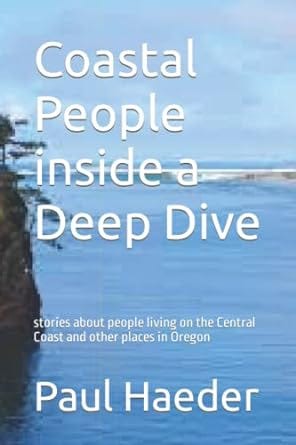
The fellow who is also a member of the Collaberative, Boone Ogden, catered the event, and I talked with him. He conducted the closing of the 4 hour event with a poem he wrote, “Reclaimed, Renamed.”
Good stuff, actually, and the words were full of that, “We Live in the Most Beautiful Part of the World” intonations with the deep nod/sadness/reclamation to the place we took from them, the Indians, the tribes. We name mountains after cartographers, mountains that have been sacred to tribes for centuries, named by them for centuries.
Holy places we turn into strip malls, big homes, parks and eateries. Their graves!
I’ll try and get Boone to send along the poem for reproduction. He blogs at the Chubby Vegetarian. His catering biz is Mandela Catering out of Seal Rock.

Finally? — Recovering the sacred.
I spent time with Winona in Spokane, and brought her to campus and for some of my work around sustainability. Here you go, my out-take:
Grain of Truth by Paul H. Haeder
You probably remember Winona LaDuke as the two-time Green Party vice presidential candidate, running with Ralph Nader in 2000 and 2004. You probably didn’t know that she’s an enrolled member of the Anishinaabeg Tribe from the White Earth Reservation in Minnesota, where she’s locked in another tough battle — this time against huge multinational corporations that want to change her tribe’s traditional way of life.
At three engagements in Spokane last week, and in some private interviews, LaDuke talked about the need to defend native peoples’ rights to the Earth. And this epic debate can fit into a single grain of wild rice — the Manoominike-Giizis strain, or the “wild rice moon” grown by her people for many generations.
This small grain of plant life serves as a microcosm of the entire sustainability challenge we all face: making sure future generations — all peoples and all species — will have a planet worth living on with ecosystems and resources to achieve spiritual and material prosperity.
LaDuke has proven to be so much more than a media darling — she’s a spiritual guide for her tribe and for the thousands she’s come across along her journey. Mixing humor with a shaman’s intensity, LaDuke has written books like All Our Relations and Recovering the Sacred.
LaDuke sees the Minnesota reservations’ practice of harvesting wild rice as vital:
“The wild rice harvest of the Anishinaabeg not only feeds the body, it feeds the soul, continuing a tradition which is generations old for these people of the lakes and rivers of the north.”
It struck me last week while spending time with LaDuke that her tribe’s battle to keep their wild rice wild, free from genetic manipulation, is a much more far-reaching illustration of what sustainability activists consider the struggle of our times: How to create an America that respects the land.
Many of us think along systemic lines, attempting to understand the steps the globe probably has to take to solve the collapsing systems, both environmental and societal. Yet we need reminding that this struggle to work with a burgeoning global human population — 9 billion by 2050 at the current 1.2 percent growth rate — needs nudging from storytellers like LaDuke.
Her struggle — our struggle — is tied to the biodiversity of wild rice, a sacred food. There are more than 60,000 acres of natural wild rice growing throughout the lakes and rivers of her tribal lands. But there are troubling parallels drawn to what’s happened to the sacred corn of Mesoamerica at the hands of the agri-business multinationals, where corn has been patented, controlled and even turned into what some call Frankenfood.
Domestication and genetic modification of wild rice threatens the genetic integrity of this plant. For more than 30 years, plant breeders have developed wild rice for commercial paddies. So today, most of the wild rice on the market comes from these paddies, almost 70 percent of it from California. “Millions of pounds of California wild rice comes into [Minnesota] to be processed,” says LaDuke, “some of that rice, if genetically engineered, would irreversibly contaminate our manoomin.”
LaDuke’s tenacity in understanding the sacred and reclaiming the wholeness of her people’s food is a valuable lesson for our times. She’s up against the juggernaut of Monsanto and Dupont, the largest seed companies in the world. Monsanto has spent $8 billion in the last few years buying up United States seed companies, while Dupont purchased Pioneer, the second largest seed company in the world.
“This concentration of control over world seed stocks is alarming to farmers on a worldwide scale, especially considering that the closer seeds seem to be held, the fewer there are.”
LaDuke puts all of our struggles into a feedback loop, connecting wild rice in Minnesota to sustainability in Spokane with the goal of creating a more independent, safe and stable food supply. “However you cut the statistics,” LaDuke says, “from the villages of India to the villages of northern Minnesota, there is a marked loss in worldwide biodiversity, and a closer hold on who controls the remaining seeds of the world.”

This issue of control took me back 32 years, to the time I was a newspaper reporter in the middle of a struggle for the soul of a mountain.
Environmentalists were trying to stop my school, the University of Arizona, from building roads and locating a large mirror telescope on Mount Graham, a 10,000-foot sky island sticking out of the Sonora Desert. Mount Graham was named after a white man who rode through the area many years ago, a Colonel James Graham, but for generations the San Carlos Apaches had referred to the entire range as “Pinaleno,” meaning “many deer.” It’s the holiest place for the Apaches, who acquire the power to become medicine men and women through singing and collecting herbs and water on that mountain.
Despite the importance and traditional use of the place, roads were cut and the telescope went up. LaDuke and I talked about that struggle, and she shared many similar struggles currently unfolding in Indian Country and elsewhere.
LaDuke’s power is in her ability to unearth the history of Native people’s struggles — and how that history is relevant today. There has been a lost connection between how the land should be used and how it actually is used — from wild rice in Minnesota to telescopes in Arizona. Reconnecting with the land is another step in the process, as her book puts it, of reclaiming the sacred.
*****
Until further notice, and more of my rants, here we go: I listened to Oren before the event last night!
This short film is part of 8 short, testimonial films, on the Haudenosaunee (Iroquois.) The Iroquois are embarking on an historic project about the 500-year history of the Iroquois, their relationship with Europe and America and their prophesies that, if heard, can help us navigate the oncoming changes due to climate change. This series of short films is done via their testimony, and creates the space for the Iroquois to tell their story as they strive to uphold the traditions and the legacy of their people while also protecting the central tenents of their people and their relationship and care for the Earth.
This series was created by Tree Media in collaboration with Oren Lyons, Sid Hill and the Haudenosaunee. This series was created with the support of the Leonardo DiCaprio Foundation and with the support of Executive Producer Oliver Stanton. For more information.
This content originally appeared on Dissident Voice and was authored by Paul Haeder.
Paul Haeder | Radio Free (2024-02-22T22:21:30+00:00) Respite: Smart People, Concerned Environmentalists, Talking Whales, Kelp, Tidepools. Retrieved from https://www.radiofree.org/2024/02/22/respite-smart-people-concerned-environmentalists-talking-whales-kelp-tidepools/
Please log in to upload a file.
There are no updates yet.
Click the Upload button above to add an update.